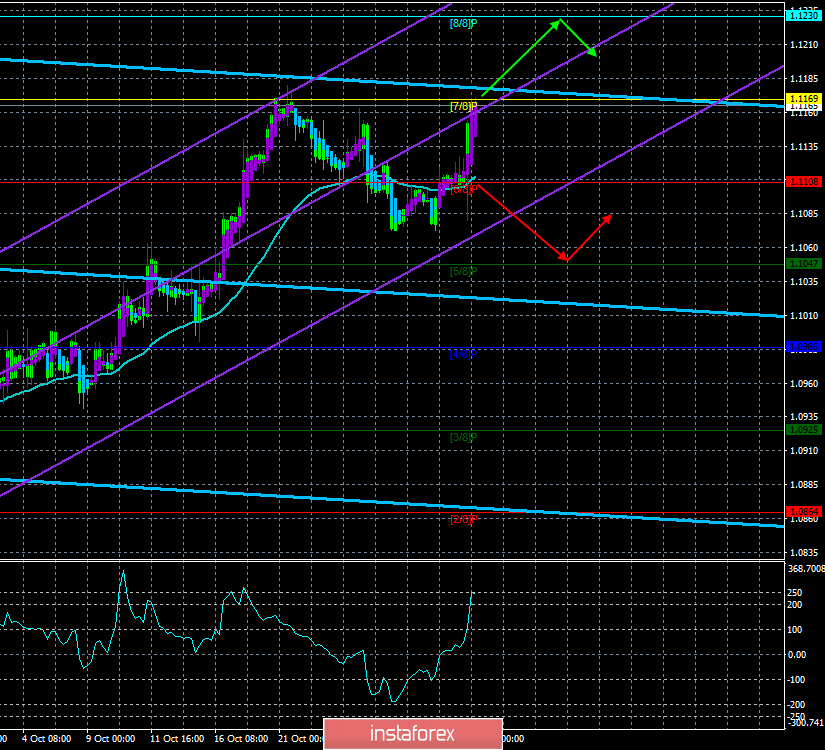4-hour timeframe

Technical data:
The upper channel of linear regression: direction – down.
The lower channel of linear regression: direction – upward.
The moving average (20; smoothed) – up.
CCI: 239.6333
On Wednesday, October 30, the EUR / USD currency pair sharply resumed its upward movement, in fact, only after summing up the results of the penultimate Fed meeting this year and the speech of Jerome Powell. All macroeconomic reports of the day, as we wrote in the evening review, were ignored. Thus, only Jerome Powell can blame the US dollar. In general, a surge in volatility last night may remain a single surge. For example, today there will be few important macroeconomic publications during the day, however, the euro currency has leaped upwards and now has all chances to continue the formation of an upward trend after a relatively small correction.
The main question after the conclusion of the Fed meeting and the announcement of its results is: are traders ready to start considering the EU currency as a tool for long-term investment? Even if we take into account the recent upward movement of the euro, it is still quite difficult to call it a full-fledged upward trend in the medium or long term. For example, the "dollar" trend, which may not be finished yet, is almost 2 years in duration. The trend for the euro is 1 month. As we have said more than once, one of the most significant factors for the exchange rate formation of the pair is the difference between the rates of the ECB and the Fed. Yesterday it declined again, and now the question is: is this new reduction enough for the US dollar to cease to be an ideal investment tool for any caliber of traders?
In his speech yesterday, Jerome Powell announced that the decision to lower the rate was made to "help keep the American economy strong in the face of global change, as well as provide insurance against current risks." However, Powell noted that the Fed will monitor changes in the labor market and inflation, as these two factors will be taken into account by the regulator in the first place when discussing changes in monetary policy in the future. In addition, Powell said that monetary policy remains in "good" condition; the Fed still expects inflation to rise to 2.0%; economic growth is still expected to be moderate (which is immediately confirmed by the GDP data released yesterday); Treasury purchases are made to expand bank reserves, and these purchases should not be confused with the quantitative easing program; the manufacturing sector and exports showed weaker dynamics than expected. There was no answer to the most anticipated question: "What course will the Fed follow in the coming months?" However, if there is no clear answer to this question, it is quite possible that the Fed does not plan to change anything in the cycle of monetary policy easing. Recall that the Fed did not announce its first cut in the key rate and subsequent ones, too. And if so, the rate cuts will continue, and the US dollar will continue to lose its strength against other currencies.
Thus, at the moment, you are obliged to state the fact: the upward trend of the euro/dollar pair is maintained, the euro currency is getting more chances to complete its two-year cycle of decline. Traders managed to work out yesterday the Murray level of "7/8" - 1.1169, but there was no rebound as such, which means a high probability of continued upward movement at least at the European trading session on Thursday, October 31. As for the macroeconomic reports of the day, today it is worth paying attention to inflation in the European Union (although this is only a preliminary value) and indicators of changes in the volume of personal income and expenditure of the American population. It is these two reports that can affect the course of trading today when a more significant fundamental event does not loom on the horizon as yesterday.
Nearest support levels:
S1 – 1.1108
S2 – 1.1047
S3 – 1.0986
Nearest resistance levels:
R1 – 1.1169
R2 – 1.1230
R3 – 1.1292
Trading recommendations:
The euro/dollar resumed its upward movement. Thus, today it is recommended to buy the pair with the target of Murray's level of "8/8" - 1.1230 if the bulls manage to overcome the level of 1.1169 (most likely, it will be possible, since there are no signs of the beginning of a correction at the moment). It is recommended to return to buying the US currency not before overcoming the moving average line with the first target of 1.1047.
In addition to the technical picture, fundamental data and the time of their release should also be taken into account.
Explanation of the illustrations:
The upper channel of linear regression – the blue line of the unidirectional movement.
The lower channel of linear regression – the purple line of the unidirectional movement.
CCI – the blue line in the indicator window.
The moving average (20; smoothed) – the blue line on the price chart.
Support and resistance – red horizontal lines.
Heiken Ashi – an indicator that colors bars in blue or purple.
Possible variants of the price movement:
Red and green arrows.





















